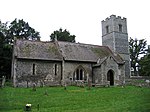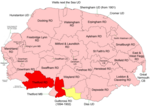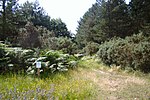Santon, Norfolk
AC with 0 elementsBreckland DistrictNorfolk geography stubsScheduled monuments in NorfolkVillages in Norfolk

Santon is a depopulated village located near Santon Downham in Norfolk, England. Moated earthworks and other remains of the medieval village are a scheduled monument.The villages name means 'Sandy farm/settlement'. The village church of All Saints' was rebuilt from ruins in the 17th century by Thomas Bancrofte, the sole parishioner at that time.The site is adjacent to the Forestry Commission's St Helen's picnic site.
Excerpt from the Wikipedia article Santon, Norfolk (License: CC BY-SA 3.0, Authors, Images).Santon, Norfolk
Church Lane, Breckland District Lynford
Geographical coordinates (GPS) Address Nearby Places Show on map
Geographical coordinates (GPS)
| Latitude | Longitude |
|---|---|
| N 52.453494 ° | E 0.68951 ° |
Address
Saint Helen's Picnic Site
Church Lane
IP27 0TQ Breckland District, Lynford
England, United Kingdom
Open on Google Maps









